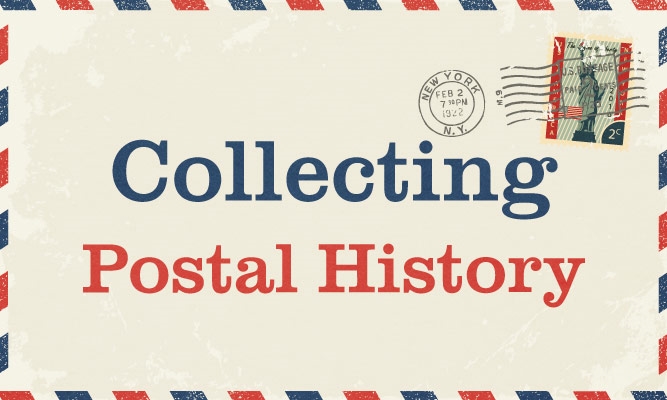Collecting Postal History

There is a post office in Anchorage, Alaska, that stamps letters to children from Santa with a “North Pole” postmark. His letters are frequently routed through that specific office before reaching their final destination.
Little post office secrets like this are one of many things that make the U.S. Postal Service so special. Other delivery services have made a name for themselves, and even more are on their way. (Listen, do you hear the buzzing of delivery drones?) But, for now, the USPS remains as a stalwart of package delivery.
For more than 200 years, postmen and women have delivered mail to homes and businesses despite snow, rain, heat, and gloom of night. None of those conditions stay those couriers from the swift completion of their appointed rounds.
And as those years passed, the technology changed. Indeed, even the department itself transformed, operating first as the United States Post Office Department from 1792-1971, operating as an official U.S. Cabinet Department for most of those years. In 1971 it became the United States Postal Service as we know it today, operating as an independent agency of the federal government—one of the few mentioned explicitly authorized in the U.S. Constitution. (It's in Article 1, Section 8, Clause 7, to be specific. You will be tested on it later.)
And as the USPS grows, changes, and adapts with the times, postal memorabilia from generations past have become collectors' items.
Postal Service Collectibles
Here are just a few relics, beyond stamp collections, now actively sought out by collectors, and occasionally found at estate sales.
Stamp vending machines
While we may not talk at length about stamps here, (that’s a whole ‘nother blog post for a whole ‘nother time), let us not ignore the methods by which many of us purchase them. The noble vending machine. Coil stamps—perforated strips, one stamp wide, coiled into rolls—were created for the express purpose of use in vending machines. (Though until 1908, they were sold without perforations.)
The vending machines were initially built by independent entrepreneurs, and not by the postal department itself, beginning in the early 20th century with the Sanitary Postage Service Corporation. During WWII, more companies came on the scene—Shipman Manufacturing Co. and the Postage Stamp Machine Co.—marketing the machine as a method to help the war effort. It wasn’t until 1948 that the Post Office Department began producing their own stamp machines.
Postmarks
When stamps were introduced in the mid-1800s, it was a two-step process: the stamp would be “cancelled” with a pen or handstamp, and then “postmarked” with the mailing location and state.
According to the National Postal Museum, while there were commercially made handstamps available, many of them were hand-crafted by postal employees themselves, often carved from wood, metal, or cork, all with different shelf lives depending on the material used. In 1904, postmasters were made to adopt standardized postmarks, making these early, unique stamps all the more valuable.
Each individual post office has it’s own individual postmark (like the one in Anchorage). There are currently more than 300,000 postal offices operating in the U.S. Offices have opened and closed, which means the number of unique postmarks is not infinite, but man if it’s not close.
There are many who actively collect postmarks as they come out—they often get updated to include more information—but if you happen to attend an estate sale of a philatelist or postal historian, you might just find your collection growing by leaps and bounds.
And if you’re really lucky, you’ll come across a retired handstamp.
Mail bags
To move the parcels between mailboxes, a wide array of containers may be used. Most notably, mailbags. The USPS has always strived to build a better mailbag. They must be lightweight and sturdy. In the case of first-class mail, they must be lockable. Depending on the mode of transportation they will be traveling (e.g. rail), they may require specialized hooks.
Vintage bags are more likely to be made of leather or canvas. In later years, post offices moved toward nylon bags and plastic sorting containers.
Postal table/Sorting case
You don’t have to be a collector of all things postal in order to appreciate the glory of the sorting case. Oh, the possibilities of personal organization that table holds.
Mr. Zip
It might be hard for young folk to believe, but in the grand scheme of things, the use of ZIP (Zone Improvement Plan) Codes is relatively new. The codes were introduced in 1963 as a new method of moving mail along in a more speedy (or “zippy”) fashion. It was easy to get mass mailers on board with ZIP codes, but the general public needed more convincing. So along came Mr. Zip.
He was an icon of the new movement—the postal office’s mascot for speedy delivery. The character was created by Harold Wilcox, an art director for AT&T, according to the National Postal Museum. His original name was the far less catchy “Mr. P.O. Zone.”
In the years he actively served as a postal mascot—from the 1960s to the early 1980s—he appeared on posters, mailing forms, lunchboxes, and of course stamps. When the USPS celebrated the 50th anniversary of the ZIP Code in 2013, he was reintroduced and given a new set of stamps.
Given the long and storied history of the U.S. Mail, the number of relics you could uncover are vast. Innovative shipping containers. Unique mail boxes. Vintage postal scales—all things an avid collector may be interested in, and a great way to start your own little treasure trove of U.S. history.